Sadly we’re not at the level of technology where the doctors could go all Deus Ex and replace my boring biological hand with an awesome robot one, so they had to settle with merely mostly fixing it. Alas. At least I have you, blog. And you, ukulele. And you, lamp. God bless you, lamp.
Oh. I have another ukulele now… wait, how long have I been trying to write this post?
K, since we’re done with wings for now, we need to figure out the other important bit: how to design the tail?
These bits at the back give us most of the control over our aircraft. If we dialled enough dihedral into the wings, we could actually ditch our ailerons entirely and just use the tail surfaces to control direction.
As we discussed way back two years ago, the tail (or empennage, depending on how french you’re feeling) is formed of two pieces: the fin and the tailplane.
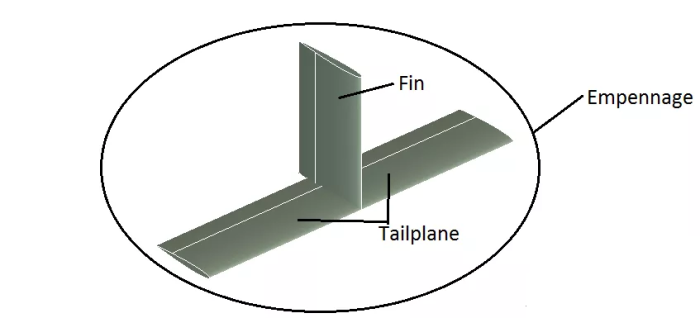
The fin is like a weathercock that keeps you heading directly into the wind, which stops you from being blown off course. Attached to the fin is the rudder, which gives us directional control. There’s relatively little complexity to the design or function of the fin, so we can rustle up a good design in a cinch. Mostly its placement and shape tend to be slaved to the design of the tailplane.
The tailplane is a counterbalance to the wing’s tendency to pitch downwards. It enables us to fly in a direction that isn’t just down. Attached to the tailplane is the elevator, which gives us control over our pitch (up and down) angle. While the elevator is simple enough to design once we have its host surface sorted out, the tailplane is more complex in function and the fin, and the rest of this post will be devoted to explaining it.
NOPE NOPE NOPE
So I’ve spent the last few months on and mostly off trying to get an explanation written out as to why the taiplane is important. So then I started trying to explain how the centre of pressure changes with angle of attack, which led me into attempting to explain pitch stability again, which of course led into HOW IS THIS MY LIFE
Ahem. This is a different and complicated kettle of fish which is best avoided for now.
SO! Below, I present my horrifyingly over-simplified (but still kind of useful) explanation on why we need a tailplane. Aerospace engineers: avert your eyes, lest ye be struck down with the stupid.
… Oh hey, it’s not actually all that terrible.
yay
Uncomfortable Balance
- If the aircraft’s weight and lift are in the same spot, the aircraft is balanced and we’re all good.
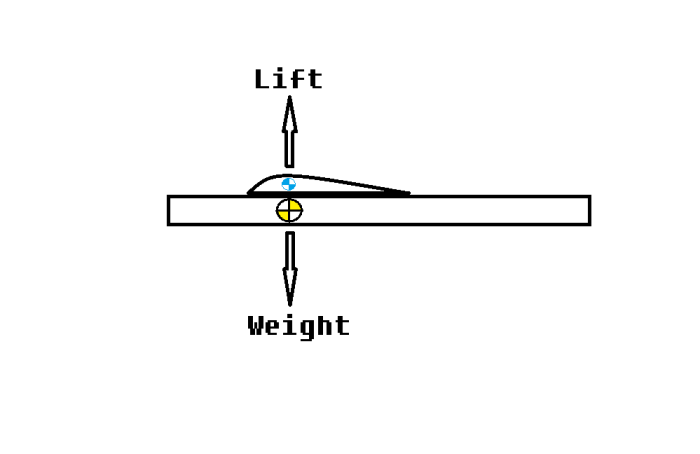
- However, this is pretty much impossible to achieve in practice, because the point at which that lift is produced moves backwards and forwards.
- Centre of lift shifts forward when you pitch up, and backwards when you pitch down.
Oh No
- If the centre of lift shifts in front of the centre of gravity, your aircraft will always want to pitch up.
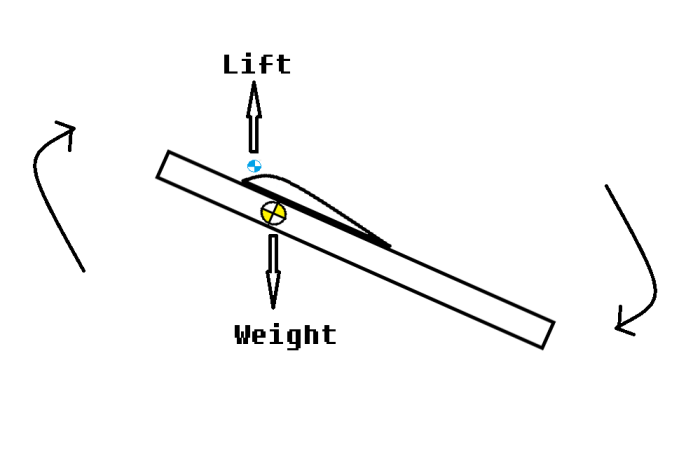
- The further the wing pitches up, the further that centre of lift is going to move forward.
- BUT wings can only produce lift up to certain pointy-uppy angles (angle of attack).
- Past a certain point, the lift will reduce and the wing will stop flying.
- This is generally regarded as being quite bad.
Also Oh No (but slightly less so)
- Push the nose down, and centre of lift will shift backwards.
- However, because the wing is pointing down, it’s now generating negative lift.
- This pulls the tail down, and the nose up, until the lift and the centre of gravity and centre of lift are occupying the same spot.
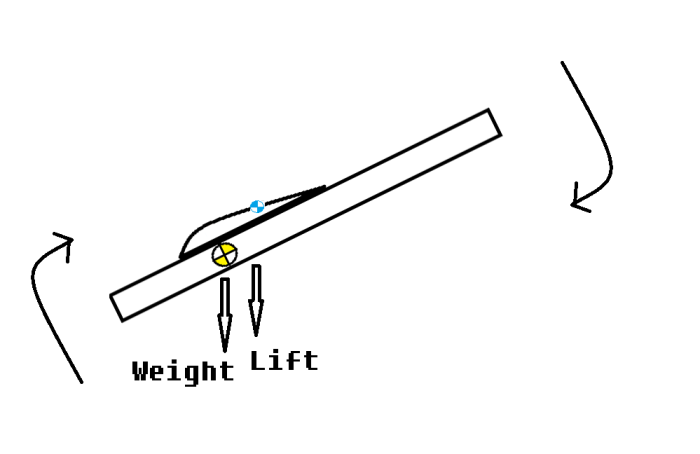
But then someone found a hosepipe - This returns us to this place:

- However, because we’re still pitching upwards, there’s going to be some overshoot, where the centre of lift is going to shift just that little bit further forwards than the centre of gravity.

Back to square one.
So…
While it would be nice to fly straight and level all the time, this is clearly impossible. This being the real world, with… you know, wind and stuff… there are inevitably going to be disturbances to our perfect flight. We need stability, and we need control.
We’ll do this by moving the centre of gravity forwards. The result?
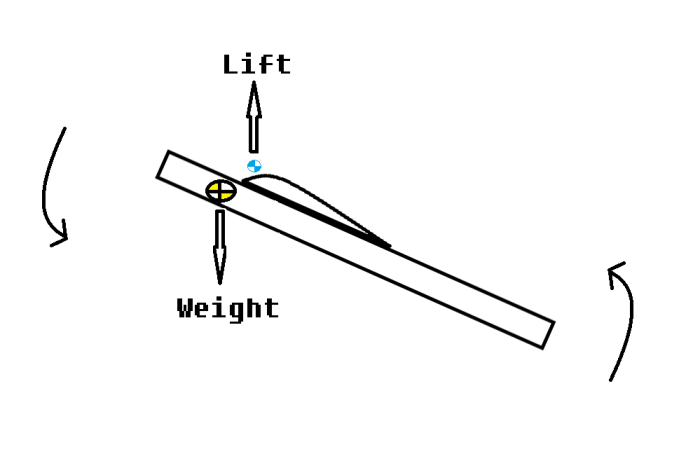
When the aircraft has its nose pushed up, the centre of lift will move further forwards… and push the nose down – up to a certain point. You could actually push the centre of gravity so far forwards that the wing will stall before the centre of lift moves in front.
Now you may be thinking something along the lines of ‘but wait, won’t that mean the plane will always want to fly into the ground?’ Further, you might be thinking ‘flying into the ground is a bad thing.’
Correct on both counts, imaginary freakishly idealised reader. However, we have achieved a key goal: stability. The plane will want to return to an equilibrium point – a specific angle of attack. However, this angle will always be negative, meaning it will always want to point groundwards.
We have achieved a stable aircraft, but not a balanced one. And we still have no pitch control.
This is why we need a tailplane – because the only way to achieve a stable flight without one will have us flying into the ground all the time*.
Here’s how they do it in the big wide world:

Now this is where it’s at (please excuse my less-than excellent MS Paint skills).
With the centre of gravity some way in front of the wing’s aerodynamic centre (the point around which the centre of lift will change – see Basics of Wings part 3), the lift being produced by the wings will want to push the nose down. However, the tailplane (which is pointing slightly downwards) will be pushing the tail downwards, and thus the nose upwards. Net effect? Nothing. Plane stays flying straight and level.
If we push the nose up, the wing lift will increase, pushing the nose back down, and the tail… let’s call it anti-lift will decrease – reducing the force which is holding the tail down, thus allowing the nose to sink. Push the nose high enough and the tail will start producing positive lift, which will really start pushing that tail back up. Combined effect? Nose falls back down.
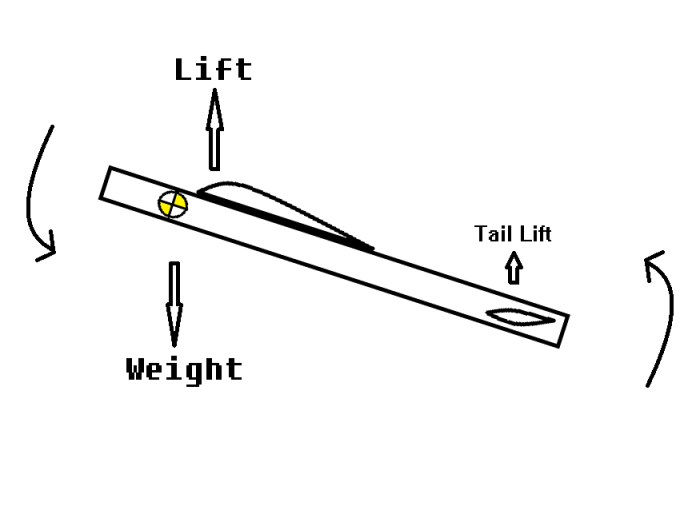
If we push the nose down, the tail anti-lift will increase, which will want to push the nose back up even more. The wing’s lift will have moved further back, which be unhelpful – however, it’s also been reduced, and as long as the tail is far enough back (we can ensure this with maths which we will avoid), will be unable to overcome the greater lever action of the tail. Back to the seesaw analogy: think big man standing close to centre of seesaw vs child at end of seesaw. That child is going to have more leverage.

NOTE: you might be wondering why the wing isn’t generating negative lift, like the tailplane would if pointed down. Most wings use aerofoils which keep generating lift, even when pointing slightly downwards. Our Clark-Y aerofoil won’t start generating negative lift until it passes about -2.5 degrees angle of attack.
Throw an elevator in, and you can fine-tune the anti-lift coming from your tailplane. Result? Pitch control. Hooray!
Well that wasn’t so bad, he said to the wall
Right. I may be wrong, but I’m fairly sure that should leave you with a reasonable understanding of why we need a tailplane. There’s inevitably more to it than what I’ve just described, but this will have to do for now. Remember when I tried to explain Reynolds numbers? Yeah, I’m trying to avoid that sort of thing now.
I’m going back to gawking at the calender and marvelling at how long it actually took to get this post out. Probably over a suitably stiff drink.
Until next time. Which shouldn’t actually be all that long now, because it’s just figuring out where and how big the tail surfaces will be.
*Note: this isn’t the case for deltas, flying wings and other tailless aircraft, but they’re designed in such a way that the wing performs the same balancing function as the tailplane would.